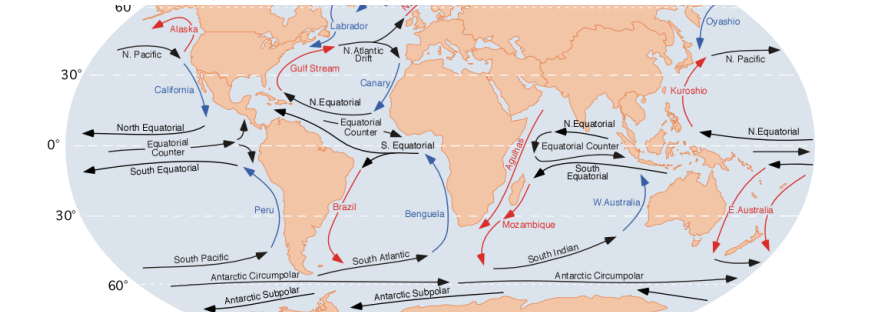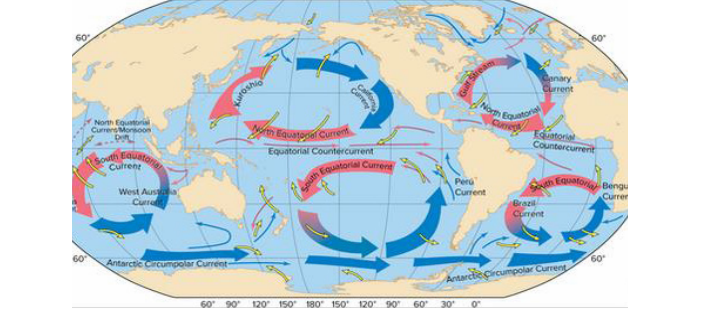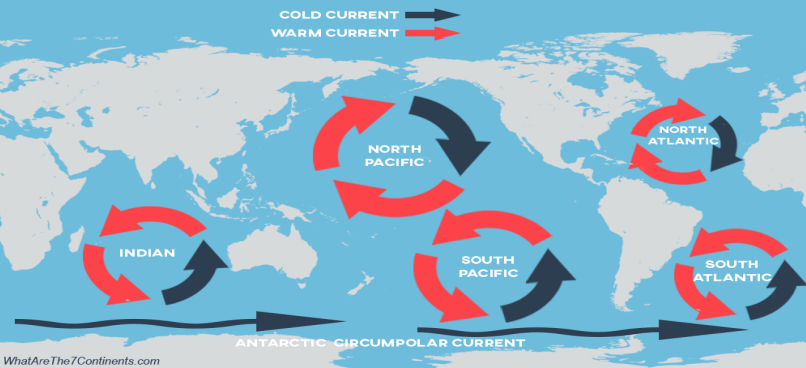
The intricate dance between ocean currents and global surface wind systems plays a crucial role in shaping the dynamics of Earth’s oceans. This interconnected relationship is a fundamental aspect of the planet’s climate system, influencing temperature distribution, marine life patterns, and weather phenomena. Wind-driven surface currents are primarily generated by the frictional drag of the atmosphere on the ocean surface. As prevailing winds sweep across the Earth, they impart their energy to the ocean, initiating the movement of vast water masses. One notable manifestation of this interaction is the formation of gyres—large, rotating systems of ocean currents. In the Northern Hemisphere, gyres exhibit distinct characteristics compared to those in the Southern Hemisphere, owing to the Coriolis effect induced by Earth’s rotation. This phenomenon results in unique circulation patterns and illustrates the nuanced interplay between atmospheric and oceanic forces. Understanding these relationships is essential for comprehending the intricate tapestry of global oceanic circulation and its profound implications on climate and ecosystems.
Answer
An ocean current is a continuous, directed movement of seawater generated by a number of forces acting upon the water, including wind, the Coriolis effect, breaking waves, cabbeling, and temperature and salinity differences.

Factors influencing Ocean currents are:
- Atmospheric Pressure and Planetary Winds:
- Coriolis Force
- Temperature
- Salinity
- Density
- Physiography
Relationship between oceanic currents and global surface wind patterns
The relationship between ocean currents and global wind patterns is crucial in understanding the movement of seawater across the Earth’s oceans.

- Cause and Effect: Ocean currents are primarily driven by the wind. Wind patterns at the Earth’s surface create friction with the ocean’s surface, transferring momentum from the atmosphere to the ocean. As a result, the surface layer of the ocean begins to move in response to the prevailing winds.
- Coriolis Effect: The Coriolis effect, caused by the Earth’s rotation, influences the direction of both surface winds and ocean currents. In the Northern Hemisphere, moving air and water are deflected to the right, while in the Southern Hemisphere, they are deflected to the left.

Examples:
In the Northern Hemisphere, the North Atlantic Drift is influenced by the westerly winds blowing from west to east. These winds drive the Gulf Stream, a warm ocean current that flows from the Gulf of Mexico towards Europe. The North Pacific Ocean experiences a similar pattern, with the Kuroshio Current influenced by the westerly winds.
In the Southern Hemisphere, the South Equatorial Current is influenced by the southeast trade winds, flowing from east to west across the tropical South Pacific. The East Australian Current is another example, driven by the southeast trade winds and flowing southward along the eastern coast of Australia.
Differences Between Northern and Southern Hemisphere Gyres:

Direction of Gyres:
- In the Northern Hemisphere, ocean gyres rotate clockwise due to the Coriolis effect, which deflects moving water to the right. For example, the North Atlantic Gyre rotates clockwise.
- In the Southern Hemisphere, ocean gyres rotate counterclockwise due to the Coriolis effect deflecting water to the left. An example is the South Indian Ocean Gyre.
Temperature and Water Masses:
- Northern Hemisphere gyres tend to transport warmer water from the equator toward higher latitudes. For instance, the North Atlantic Gyre carries warm water towards northern Europe, influencing the region’s climate.
- Southern Hemisphere gyres transport cooler water from higher latitudes towards the equator. The South Pacific Gyre, for example, brings colder waters from the Southern Ocean towards the tropics.
Size and Strength:
- Northern Hemisphere gyres are generally larger and more powerful due to the larger landmasses and greater temperature differences between the equator and the polar regions in the Northern Hemisphere.
- Southern Hemisphere gyres are smaller and less intense because there are fewer large landmasses to disrupt their circulation patterns, and the temperature gradients are not as pronounced.
Understanding these differences in gyres is essential for predicting climate patterns, marine ecosystems, and even the distribution of marine resources in different parts of the world’s oceans.
In case you still have your doubts, contact us on 9811333901.
For UPSC Prelims Resources, Click here
For Daily Updates and Study Material:
Join our Telegram Channel – Edukemy for IAS
- 1. Learn through Videos – here
- 2. Be Exam Ready by Practicing Daily MCQs – here
- 3. Daily Newsletter – Get all your Current Affairs Covered – here
- 4. Mains Answer Writing Practice – here

